
The teeter totter, the dog walk and the big fat butt
The last training place we went to, the instructors had us doing the ladder and Toby walked all over the rails and back and forth and generally would not stay in the middle. So their grand idea was just to put him up on the full height dog walk and have him go and he'll realize that there's nothing under him. Like Toby's going to suddenly have an epiphany about spacial relations and gravity! So he did it once and it was fine. Then he does it a second time and he falls off! Luckily, I was in the right place to catch him. He just laid there, upside down and confused while I carried him back to the beginning and put him back on. This happened twice! Another time, they had us on the teeter totter and he fell off of that! For some reason, I just don't think that was the best theory for a dog with no fear! Thankfully, he's never been hurt and never gained a fear of the obstacles. So at this new training center, the instructor's great! The problem, we are still having wide butt issues. Of course she knows that he needs to learn to put one foot in front of the other and walk like a supermodel but so far, he's just not getting it. So, how do we teach them to do the skinny walk on these obstacles? |
|
|
| I'm glad you caught him.
Maybe you could show Toby a few episodes of "Coming to America...?"  |
| Maybe I'll just get him the really tight dress! |
| sigh.................... i have wide butt issues too |
| Just teach him to suck in his cheeks.
But seriously... how do you teach a dog to walk a tightrope? |
| I'll be there this weekend - I'll give him some
pointers- I have the fat butt walk covered It's natural for me... (sorta like good food - you go where the fat people live. You gotta learn from the fat butt people.) I rarely fall off- Shellie |
| You really need to lower the dog walk and have him practice.
Marley was raised in a performance house and had to have knowledge of her rear end and feet to get food from an early age. I started Morgan at about a year in agility and the difference in ther spatial knowledge was very evident., That said, they have both taken spectacular falls - never seems to bother them though. If you have to train on the full height I would use treats at very short intervals to get him to walk slowly (and someone needs to "spot" his rear quarters) Hopefully Kristine will also weigh in as she probably has a secret. |
Maxmm wrote: Maybe I'll just get him the really tight dress!
Ah, Toby. Why am I not surprised? This is really common in OES. Got a ladder at home? Take it out and place it on the ground somewhere (I made one - of course! picture tonight) I start all of mine as puppies - that way they actually fit between the rungs and as they grow into their big-buttedness, they are more apt to remember that the PLAN is to stay between the rungs. At least that's the theory. When I start an older dog they do exactly as Toby did to start - walk on the rungs, outside the rungs, trip and fall on their nose. It ain't pretty. Here's what I do: Grab clicker. Lure dog through ladder with treat low and in front of nose at a walk (!) as many times as it takes to get them to move forward with their head down paying attention to their feet. Some times you only get two rungs to start. Yay! Stop and party. Keep doing this for a couple minutes every day until he starts to trot slowly (!) and nicely through it on his own. Wean off luring as quickly as you can so he doesn't trot through with his head up eyeing the treat dispenser (that would be you Point is to encourage slow and deliberate (I know - contrary to everything else you do in agility) because fast begets sloppy and careless. You have to encourage them to think their way through. Think of it this way: you're learning some new dance steps. In the beginning you have to think through every move and then your brain sends that message to the appropriate body parts. You focus hard at this point at getting it RIGHT. Because for every time you do it, you're building muscle memory. Eventually you don't have to think, your muscles, when cued this is what I want you do, just *know* that it requires this and this to make that happen. Totally subconscious. The way we all learned to walk, in fact. Do most of us think about walking? No, we think that we want to get from point A to point B in an upright position and we do. Toby's learning to get from point A to point B without Mandy ending up needing back surgery from catching him, he has to bring his legs underneath him and towards the line of gravity. Other good exercise: teach him to back up (you're going to need this when you compete in Rally excellent some day anyway.) At first while standing in front and facing you. Take one step towards him, making him move backwards and out of your way, treat in hand and low so as to not indavertently signal him to sit. One step backwards, click and treat. Eventually you fade the movement. You add a verbal cue with what has become a hand signal. You ask for one more step at a time. You transfer it to standing next to you (and then heeling next to you) What does this do beyond impressing your friends (or making them think you need to get a life?) A quadruped can't back up straight (!!) without knowing where your rear is, you know? Also (you didn't think I was done yet, did you? Books should be written on the average OES' lack of rearend awareness!!!) you can put a 12" wide say maybe 8' long board (2" width so it's sturdy) on two cinder blocks. Dog jumps onto board. You walk back and forth rewarding when he keeps his feet on and ignoring when he falls off trying to crane his head towards your hand (you have the treats, you know). Watch him when he does this - and he will. Where the head goes, the body will follow. Basic physics. Ergo, you want to encourage him to walk, then trot, then canter across the board actually looking in the direction of travel and not checking out the handler to see which pocket she has the cookies in. You teach them to turn around on the board, to sit and down on the board and, eventually, to back up on the board. They're less than a foot off the ground, so they can't hurt themselves. But boy can they learn a lot about how to control their bodies. Oh, yeah, and this happens over weeks and months, not days. But only a few minutes at a time. Baby steps. In time he will OWN the dogwalk and teeter board. Unless a cute OES chick wiggles by. Then all bets are off. Some pictures tonight if the T-storms hold off. Kristine |
Ron wrote: Just teach him to suck in his cheeks.
How EXACTLY does one suck in their cheeks? That is a skill I'd like to learn!!! |
| This new instructor won't let a dog on a raised obstacle until she's sure they won't hurt themselves so good stuff there! That other school was just about getting cute pictures of dogs on the obstacles not really getting results!
I think that the 2 and 3 steps on the ladder are what may work. It seems like we get a couple of steps with me bent over, treat in hand and when he doesn't get the treat he kicks out trying to get a better angle at it. So if I stop before he reaches that annoyed, I didn't get the food yet, point it may get better results. The instructor did say to go out and get a 12" by 12' board and lay it on the ground to practice so I may start there and then put the blocks under it in a little bit. At class last night, I threatened to get the board but put walls on it and stuff him in! On another agility topic. This instructor cannot stop laughing at Toby! She finds it hilarious when he goes through the tunnel because it fills up and all you can see is hair. And we were working on the chute last night. All the other dogs would duck down when she started lowering it but not Toby! He actually puffed the chute out and she kept making him do it over and over again so she could giggle about how big the chute got. She kept apologizing between giggles! |
| ^^^
She would have been hysterical when Morgan decided the chute made a better table and for about two months refused to go in it but would jump up and stand on it! My instructor never designed so many courses with chutes in her life as she did when he was going through that. |
| LMAO....
I'm seriously thinking Bree will make a great agility dog when she's done with conformation... She thinks she can fly, stop on a dime, come full circle and fly over the gate from a sit so still and almost perfect it boggles my mind! (except for her butt wiggling furiously in anticipation of a treat, or inability to hold completely still, not sure which) |
Maxmm wrote: This new instructor won't let a dog on a raised obstacle until she's sure they won't hurt themselves so good stuff there! That other school was just about getting cute pictures of dogs on the obstacles not really getting results!
Smart and sounds familiar Though OES in coat do take awesome pics in tunnels. If I ever finish unpacking I'll scan something of Mad's. At local NADAC trials she was jokingly offered a job as a pipe cleaner. One of the workers threatened to soak her in soap and water before I ran the course Kristine |
| OK, as threatened, eh, promised:
I made my own ladder so I could have different heights. Plus, I wanted some control over the dimensions. Plus...who knows? You don't need to, but being able to have different heights does come in handy. Regular height: 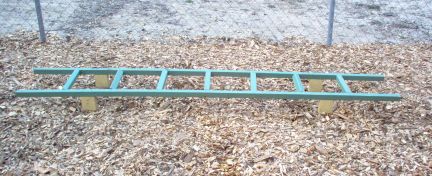
What I start puppies on: 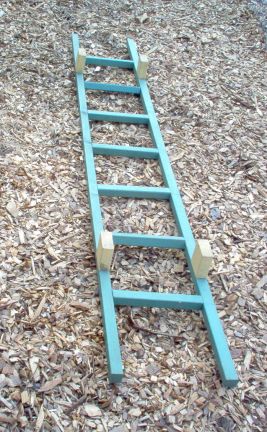
Did I mention the dog is supposed to walk/trot through looking where they are going? This is Sybil faking it - evidently she needs to track through the ladder Truth is, I haven't used it for a long time and we'd been working a lot on the flat board, so she actually tried to balance ON the rungs. Over all it wasn't pretty. Refresher course here we come. You can also teach them to back up through the ladder, but most dogs learn to go forwards first... 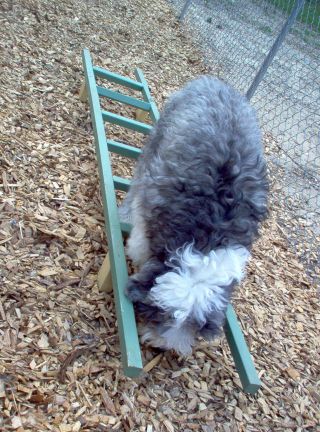
Kristine |
| What are the dimensions? width of the ladder and spacing between the rungs?
Nice looking chips there too, BTW! |
| You can and probably should start with a flat board.
Painted because I added texture: 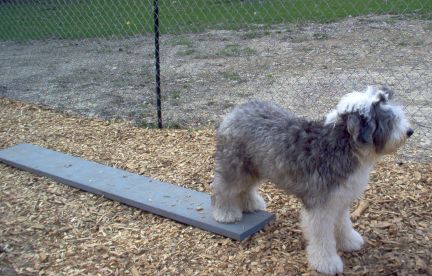
For teaching them to keep all four feet on the board, I prefer a little height only so it's easier to make the distinction - for them and me. Sitting: 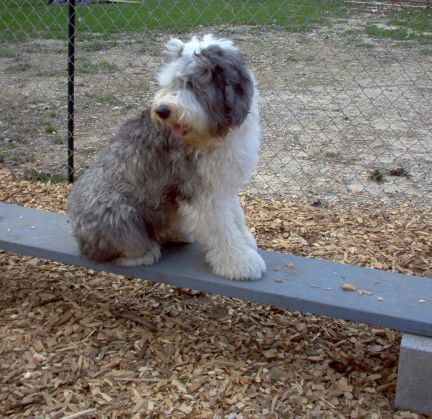
Downing: 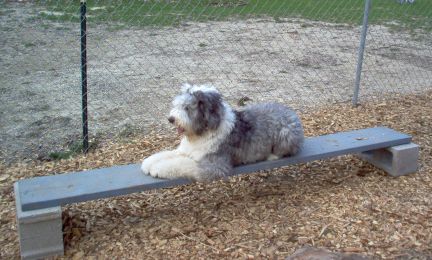
Barking (at neighbor): 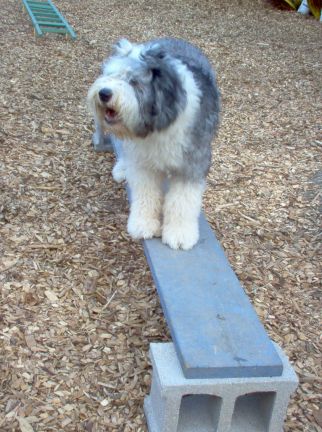
Trotting across: 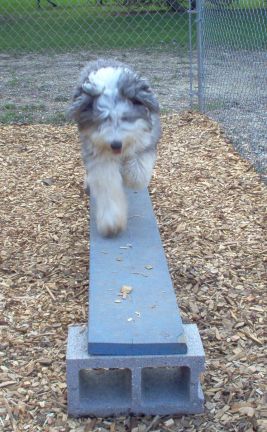
Parking <?>: 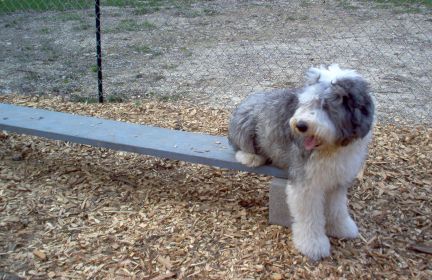
Lotsa possibilties. Even if you don't get too hung up on the ladder exercises, playing with the board at a low height pays huge dividends. Kristine |
got sheep wrote: What are the dimensions? width of the ladder and spacing between the rungs?
Nice looking chips there too, BTW! You WOULD ask Since it's dark now, I'll measure when I get home from work tomorrow. It's not critical that you make your own and I literally made it up as I went along. And aren't the chips pretty??? They're still new enough that I can easily determine poop vrs chips... Kristine |
| Talk a little bit about the raised ladder. I'm really afraid that if I did that Toby would absolutely become entrapped in it or break a leg due to being uncoordinated! |
Maxmm wrote: Talk a little bit about the raised ladder. I'm really afraid that if I did that Toby would absolutely become entrapped in it or break a leg due to being uncoordinated!
If you're concerned but want to use a ladder, find a nice regular heavy one and lay it flat on the ground. Mine is pretty lightweight but surprisingly stabile on the ground. Sybil was literally walking on top of it last night It's like anything else - you introduce it carefully. Though I've never had an issue, and I'll often just leave it out in the dog yard where it's been mauled by puppies and rescue fosters alike in play and nosiness. It doesn't budge and they don't tangle. But that's not to say that a determined and innovative dude couldn't figure out a way... You need to go with whatever you feel comfortable with. Kristine |
| So Monday night we went to class and guess what? We did the teeter totter while it was on the ground with just a little bit of the wobble left in it and Toby did it perfectly!! WooHoo!!
Still need more practice for the dog walk, he leans a bit but much better!! |
| Yay Toby!!!
Pictures please! I want to see Toby |
| I'll have to see who I can get to come along to class. The boyfriend's sister brings her GSD but I don't know if we are good enough to concentrate on class and remember to take pics!! |
Maxmm wrote: So Monday night we went to class and guess what? We did the teeter totter while it was on the ground with just a little bit of the wobble left in it and Toby did it perfectly!! WooHoo!!!
I am not surprised - that's Marley's favorite obstacle! |
| Harry can't wait to see Toby doing agility again (maybe Nationals?). We never learned the ladder thing but Harry doesn't have too many issues with the dog walk or teeter - in fact he will often turn around right in the middle when he acknowledges that he was not "sent" to do the obstacle. Maybe 2008 is the year for working out agility issues Mandy. Switching trainers was the best thing I could have done for Harry so I am glad you are going some place new. |
Didn't find exactly what you're looking for? Search again here:

Custom Search
|
|
| |
|
|
|
|
|